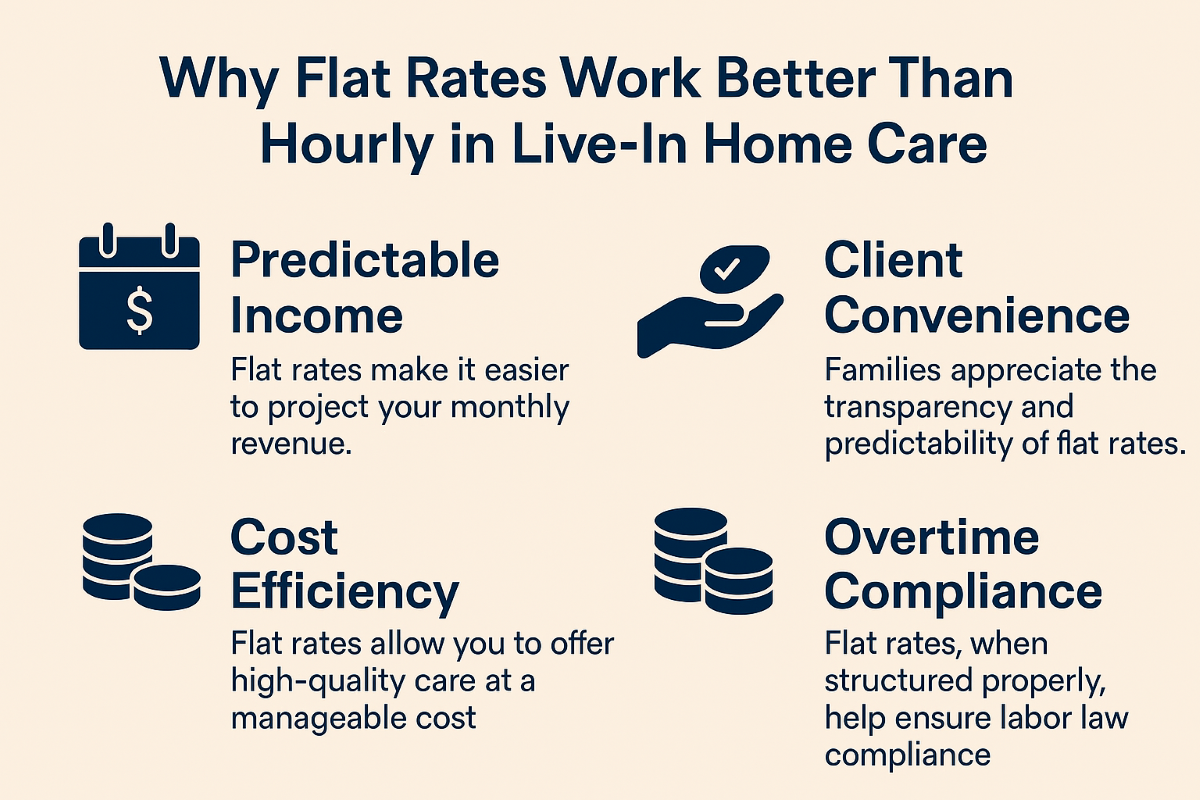How Much to Charge Your Live-in Home Care Client
If you're running a home care agency in Texas, you already know that setting rates for live-in home care isn't as simple as pulling numbers from a spreadsheet.
Families want transparency, and your caregivers need fair compensation. You need to manage expectations on both ends while staying compliant with labor laws. But if you're relying on hourly pricing, you'll most likely be running into billing complications, overtime issues, and caregiver burnout.
So how do the best agencies price live-in home care services without losing money or trust?
Today, we will show you why flat rates work better, what current rates look like across Texas in 2025, and how to structure your pricing in a way that supports your business, your team, and your clients.
Why Flat Rates Work Better Than Hourly in Live-In Home Care

Charging a flat daily or monthly rate simplifies everything. Instead of tracking hours and calculating overtime, you have a clear number that reflects the care being provided and the cost of delivering it.
Here are the main reasons why flat rates work better:
Predictable Income
Flat rates make it easier to project your monthly revenue. Whether you’re billing $375 a day or $12,000 a month, you’re not waiting on hourly tallies, late timecards, or client disputes over time tracked. You know what’s coming in and when.
Client Convenience
Families appreciate the transparency and predictability of flat rates. Most families don’t want to track care down to the minute. They want to know what they’re paying each day or each month, with no surprise bills for extra hours or unexpected services. Flat rates eliminate confusion and allow for clearer contracts.
Cost Efficiency
If you charge $25 an hour for 24-hour care, the client ends up with a $600 daily bill. Over 30 days, that’s $18,000. Most families can’t afford that.
But a flat daily rate of $375 keeps costs closer to $11,250 per month, which is still a significant investment, but far more manageable. Flat rates allow you to offer high-quality live-in home care at a cost that clients can plan for.
Overtime Compliance
Under federal labor laws, most live-in caregivers are entitled to overtime after 40 hours per week. That means hourly billing must account for time-and-a-half, even if the caregiver lives in the home. Flat rates, when structured properly and backed by rotational scheduling, make it easier to stay compliant while compensating your team fairly.
The Problem with Hourly Billing for Live-In Home Care
Hourly billing has its place in short-term care or daytime shifts, but it creates real challenges in live-in home care. Here’s why:
It Encourages Overworking Caregivers
If you try to stretch one caregiver over 24 hours just to keep the client’s bill low, you’ll burn that caregiver out. Overtime laws exist for a reason. Hourly billing makes it harder to split shifts across two caregivers without drastically increasing the client's bill.
It Creates Payment Disputes
Clients might question why they’re being billed for hours the caregiver was “resting” or “waiting around.” Even if the caregiver is available and on duty, hourly billing opens the door for debates over what time should be compensated. Flat rates avoid this altogether.
It Doesn’t Reflect the Nature of Live-In Support
Live-in home care isn’t about clocking in and out. It’s about consistency, safety, and peace of mind. A flat rate better reflects the value of uninterrupted presence, even if the caregiver isn’t performing hands-on care every hour.
What Are Current Live-In Home Care Rates in Texas? (2025 Data)

Pricing varies, but understanding the market average gives you a strong starting point. As of 2025, here’s what most agencies across Texas are charging:
-
Hourly Rates: $24 to $31 per hour
-
Daily Flat Rates: $350 to $450 per day
-
Monthly Flat Rates: $10,500 to $13,500 for a 30-day month
These numbers are based on average care needs. You’ll need to adjust based on factors like caregiver skill level, location, and client health status.
Factors That Should Shape Your Pricing
Your live-in home care rate should be fair, competitive, and sustainable. Here’s what to consider before finalizing your rates.
1. Level of Care Needed
Not every client requires the same level of support. That’s why your pricing must reflect the actual workload.
-
Companion Care: If your client needs help with meals, bathing, and companionship, you can lean toward the lower end of your flat rate range.
-
Specialized Care: Clients with dementia, physical limitations, or chronic health conditions need caregivers with specific training. That warrants higher rates to account for increased responsibility and liability.
2. Location Within Texas
Texas is big, so rates vary across based on regional cost of living and demand for care
-
Urban Centers: Areas like Houston, Dallas, and Austin tend to have higher demand, higher labor costs, and a more competitive market. Flat rates of $400 to $450 per day are standard.
-
Rural Areas: In smaller towns, the same service might cost closer to $325 to $375 per day, depending on caregiver availability and cost of living.
3. Scheduling Model
How you schedule your caregivers has a direct impact on what you need to charge.
-
Single Live-In Caregiver: If one caregiver stays with the client five to six days a week, you’ll need to account for overtime pay unless your arrangement qualifies for specific exemptions.
-
Rotational Shifts: Many agencies use a 4/3 split (one caregiver works four days, the other works three). This reduces overtime, supports better caregiver health, and helps ensure coverage for weekends. It does, however, slightly increase your cost, so your flat rate should reflect that.
Why Families Appreciate Flat Rates
Families facing long-term care decisions already feel the weight of uncertainty. Flat rates help reduce that stress in key ways:
-
Clear Expectations: They know what they’re paying each month. No guesswork, no hourly overages.
-
Easier Budgeting: Most families use long-term care insurance or retirement funds to cover care. A consistent rate is easier to manage and justify.
-
More Trust in the Agency: When your pricing structure is clear and consistent, it builds credibility. Clients see your agency as organized, transparent, and professional.
Staying Compliant: What You Need to Know
Pricing isn’t just about what works for your business. It must align with state and federal laws. Here are three things you must do to keep your pricing legally sound:
1. Overtime Regulations
Every live-in caregivers are often entitled to overtime pay unless they meet specific exemption criteria. Flat rates should reflect this. If you’re not sure, consult a labor attorney who understands home care law in Texas.
2. Rest Breaks and Sleep Time
You can’t assume caregivers are off-duty just because it’s nighttime. You must have written agreements about sleep time, rest periods, and how they’re handled in your rate.
3. Written Agreements
All live-in home care arrangements should be backed with clear contracts that define rates, responsibilities, and expectations. This protects everyone and prevents misunderstandings.
How to Set the Right Rate for Your Live-In Client
If you're setting your rate for a new client, here’s a quick process to follow:
-
Evaluate the Client’s Needs: Understand whether the care is basic or complex.
-
Check Your Location: Compare with other agencies in your area charge.
-
Determine Scheduling Model: Will you need one caregiver or two rotating?
-
Calculate Cost of Delivery: Factor in payroll, benefits, and operations.
-
Add Margin for Stability: Build in a buffer for agency operations, compliance, and caregiver turnover.
Example:
Let’s say you’re serving a client in Dallas who needs dementia care. You use two caregivers on a 4/3 schedule. Each caregiver makes $250/day, plus payroll taxes, insurance, and admin costs. You might set a daily rate of $425 to ensure you stay profitable while remaining competitive.
Final Thoughts
Live-in home care is not just another service. It’s one of the most complex and meaningful care arrangements an agency can offer. That’s why your pricing model must be clear, legal, and financially sound.
Flat rates allow you to offer consistent care without creating stress for your clients or your team. Hourly billing leaves too much room for confusion, overtime violations, and unexpected costs.
So, set rates that reflect the real value of care. Build schedules that protect your caregivers. Structure your agreements so that clients feel secure. That’s how you run a sustainable, respected agency in today’s home care market.